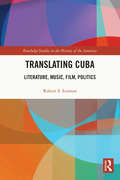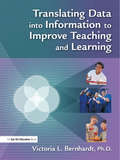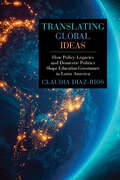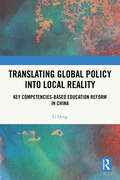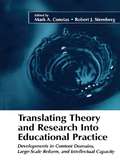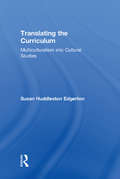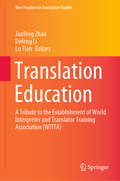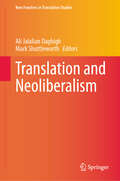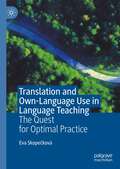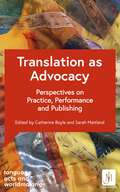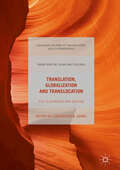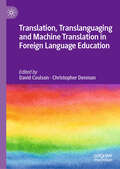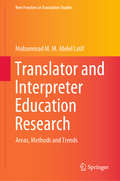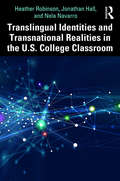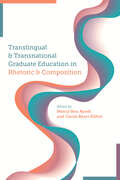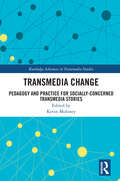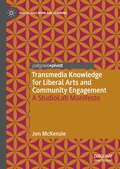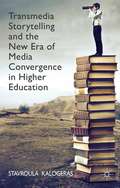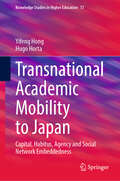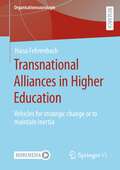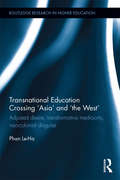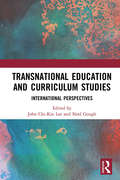- Table View
- List View
Translating Aunt Edna
by Rhonda TelferThree boys decide to play a trick on their aunt, who insists on teaching them new vocabulary words. The English language can be complicated. There are so many words that describe the same thing! You can learn about many of those words in this silly story about a group of siblings who decide they are sick of learning new words!
Translating Cuba: Literature, Music, Film, Politics
by Robert S. LesmanCuban culture has long been available to English speakers via translation. This study examines the complex ways in which English renderings of Cuban texts from various domains—poetry, science fiction, political and military writing, music, film—have represented, reshaped, or amended original texts. Taking in a broad corpus, it becomes clear that the mental image an Anglophone audience has formed of Cuban culture since 1959 depends heavily on the decisions of translators. At times, a clear ideological agenda drives moves like strengthening the denunciatory tone of a song or excising passages from a political text. At other moments, translators’ indifference to the importance of certain facets of a work, such as a film’s onscreen text or the lyrics sung on a musical performance, impoverishes the English speaker’s experience of the rich weave of self-expression in the original Spanish. In addition to the dynamics at work in the choices translators make at the level of the text itself, this study attends to how paratexts like prefaces, footnotes, liner notes, and promotional copy shape the audience’s experience of the text.
Translating Data into Information to Improve Teaching and Learning
by Victoria L BernhardtHere it is ... the latest from best-selling author Victoria Bernhardt. This book helps educators think through the selection of the data elements and data tools needed to support quality decisions for improving teaching and learning. It shows you how to use data to help make decisions about strategies to improve student achievement.
Translating Global Ideas: How Policy Legacies and Domestic Politics Shape Education Governance in Latin America (SUNY series, Education in Global Perspectives)
by Claudia Diaz-RiosInternational organizations have consistently influenced education reforms in Latin America, but not all countries have adopted the same policy recommendations. This book offers a unique comparative analysis of secondary education reforms in Chile, Argentina, and Colombia, from the 1960s to the 2010s, with a focus on three key areas: manpower planning, state-retrenchment (market-based versus active-state), and ideas about having a right to a quality education in an era of government accountability. While responding to similar policy recommendations, these countries have differed in how they have implemented decentralization, incorporated private actors, allocated authority over curriculum, and established instruments of accountability. Claudia Diaz-Rios traces the legacies of previous education policies and local struggles among stakeholders in reshaping—and sometimes rejecting—foreign recommendations. Translating Global Idea will be an invaluable resource for scholars of comparative politics and the globalization of education—particularly those interested in policy development in middle- and low-income countries, as well as practitioners invested in promoting education policy changes in Latin America.
Translating Global Policy into Local Reality: Key Competencies-Based Education Reform in China
by Li DengThis book analyses the global diffusion of key competencies-based education (CBE) as a “global education policy” (GEP), focusing on China’s process of adoption and adaptation.Based on a six-year empirical study combining interviews, observations, and document analysis, it examines how national and local actors interpret, modify, and resist CBE. Constructing and applying a four-stage framework for the GEP transfer process, the book integrates macro-level analysis of global forces with micro-level analysis of specific policy changes at the national level, and bridges theoretical and practical perspectives through both macro-level policy analysis and micro-level case studies.The book provides valuable insights and implications of policy formulation and educational practice for educators, policy makers, and researchers interested in the dynamics of global policy transfer, localised educational reforms, and the complexities of reform in a globalised world. The case study of China’s implementation and localisation of CBE will also inform global efforts to adapt and integrate CBE in diverse educational contexts.
Translating Theory and Research Into Educational Practice: Developments in Content Domains, Large Scale Reform, and Intellectual Capacity (Educational Psychology Series)
by Mark A. Constas and Robert J. SternbergThis book shows, in detail and with concrete examples, how educational theory and research can be translated into practice. Well-known researchers who have worked to establish productive, sustainable connections between the knowledge produced by the research community and the practices employed in school settings provide descriptions of successful strategies that have been used to bridge the gap among theory, research, and practice. The volume addresses three main themes: *analysis of how educational theory and research may be used to improve student learning and achievement in mathematics, science, and reading; *examination of how educational theory and research has been used to conceptualize, implement, and evaluate the effects of challenges of large-scale reform; and *exploration of how different models of intelligence and creativity have informed educational practice. Viewed as a collective effort to translate theory and research into educational practice, the interventions and programs described by the contributors to this volume represent nearly 200 years of work. As a compendium of successful strategies, this book will help others identify ways to make their own research more useful to their practice communities. As an investigation of persistent, seemingly intractable problems encountered when attempting to connect theory and research to the everyday work of teachers and students in classrooms, the analyses presented in this volume demonstrate where additional work is needed. By examining critical, persistent challenges encountered when attempting to connect educational theory and research to the everyday work of teachers in classrooms and schools, this book will help improve the practical value of educational research and help chart the course for future research.Translating Theory and Research into Educational Practice is intended as a text for advanced undergraduate and graduate courses across the discipline of education and should be particularly relevant for classes dealing with educational research, educational policy, and teaching and learning. The book is equally relevant for various communities interested in improving connections between research and practice, including educational researchers, educational psychologists, psychologists, teachers, other educational professionals such as state school officers, district officials, and policy makers. The authors' comprehensive descriptions and critical reflections will provide readers with valuable insights about the practical demands, theoretical complexities, and political realties associated with efforts to translate theory and research into effective educational practice.
Translating the Curriculum: Multiculturalism into Cultural Studies
by Susan Huddleston EdgertonAlthough recent theory in multicultural education has acknowledged what has been called "the new cultural politics of difference," problems concerning what actually passes for multiculturalism have been underexamined. Translating the Curriculum proposes that a new theoretical and practical lens through which to examine multicultural education is necessary and suggests that it may be found in cultural studies. Edgerton looks at pedagogy through structuralist and poststructuralist philosophy and social theory, literary criticism, literature, and autobiography. Using this interdisciplinary approach, notions of marginality, essentialism, identity and translation across difference are explored.
Translation Education: A Tribute to the Establishment of World Interpreter and Translator Training Association (WITTA) (New Frontiers in Translation Studies)
by Defeng Li Junfeng Zhao Lu TianThis book features invited contributions based on the presentations at the First World Interpreter and Translator Training Association (WITTA) Congress, held in Guangzhou, China, in November 2016. Covering a wide range of topics in translation education, it includes papers on the latest developments in the field, theoretical discussions, and the practical implementation of translation courses and programs. Given its scope, the book appeals to translation scholars and practitioners, education policymakers, and language and education service providers.
Translation and Neoliberalism (New Frontiers in Translation Studies)
by Mark Shuttleworth Ali Jalalian DaghighThis book explores the intersections of neoliberalism, translation, and interpreting, a scarcely explored topic in the field of translation studies across diverse regions, including Europe, North America, Asia, and Australia, covering four primary themes that offer unique perspectives on how neoliberal ideologies influence translation and interpreting. The first theme uses data triangulation to delve into the influence of market-driven ideologies on translation and interpreting curriculum globally as well as the neoliberal tendencies of the trainees in China and Korea. The second theme investigates the effects of top-down neoliberal policies on translation services and practices in Australia, Canada, and the UAE, examining how these policies influence service quality, working conditions, and the balance between market demands and academic requirements. The third theme assesses the influence of technology and neoliberalism on the translation and interpreting labor market, providing a critical analysis of the automation of translation workflows, the rise of non-standard employment arrangements, and the socio-economic challenges faced by translation professionals. The final theme analyzes the intersection of neoliberalism and translation at the discourse level, employing various approaches including critical discourse analysis and content analysis to explore how neoliberal values manifest in translated texts and practices in China, Iran, and USA. This book is an essential resource for academics, postgraduate students, researchers, policymakers, educators, and practitioners interested in the dynamic interplay between neoliberalism and translation, offering new insights and critical perspectives that contribute to a deeper understanding of the socio-economic forces shaping the field of translation and interpreting.
Translation and Own-Language Use in Language Teaching: The Quest for Optimal Practice
by Eva SkopečkováThis book reconsiders the role of translation and own-language use in the EFL (English as a Foreign Language) classroom. It shows prospective teachers how to use the learners’ own language and translation optimally. The author surveys current research about the EFL classroom and presents both a theoretical framework and a didactic model for using translation and learners’ mother tongues. This is done through an action research project, assessing the proposed didactic model for optimal translation practice in English Language teaching (OTP in ELT) through its integration into teacher education. The book will be of interest to students and researchers in the areas of Translation Studies and Applied Linguistics (particularly EFL, ESL, TEFL and TESOL), as well as educators and designers of pre-service training programmes for language teachers.
Translation as Advocacy: Perspectives on Practice, Performance and Publishing (Language Acts and Worldmaking)
by VariousWhat does it mean to advocate - in translation, for translation, through translation? What does advocacy look like, for those who do the translating or for those whose work is translated? To what extent is translation itself a form of advocacy? These 'what' questions are the driving force behind this collection.Translation as Advocacy highlights the innovative ways in which translator-academics in seven different fields discuss their practice in relation to their understanding of advocacy. The book aims to encourage people to think about translators as active agents bringing new work into the receiving culture, advocating for the writers they translate, for ideas, for practices. As such, the book asserts that the act of translation is a mode of cultural production and a political intervention through which the translator, as advocate, claims a significant position in intercultural dialogue.Featuring seven interrelated chapters, the book covers themes of judgement, spaces for translation, classroom practice, collaboration, intercultural position, textuality, and voice. Each chapter explores the specific demands of different types of translation work, the specific role of each stage of the process and what advocacy means at each of these stages, for example: choosing what is translated; mediating between author and receiving culture; pitching to publishers; social interactions; framing the translation for different audiences; teaching; creating new canons; gatekeepers and prizes; dissemination; marketing and reception. This book repositions the role of the translator-academic as an activist who uses their knowledge and understanding to bring agency to the complex processes of understanding across time and space. Moving critically through the different stages that the translator-academic occupies, using the spaces for research, performance and classroom teaching as springboards for active engagement with the key preoccupations of our times, this book will highlight translation as advocacy for students, educators, audiences for translation and the translation industry.Like all the volumes in the Language Acts and Worldmaking series, the overall aim is two-fold: to challenge widely-held views about language learning as a neutral instrument of globalisation and to innovate and transform language research, teaching and learning, together with Modern Languages as an academic discipline, by foregrounding its unique form of cognition and critical engagement.Specific aims are to:· propose new ways of bridging the gaps between those who teach and research languages and those who learn and use them in everyday contexts from the professional to the personal· put research into the hands of wider audiences· share a philosophy, policy and practice of language teaching and learning which turns research into action· provide the research, experience and data to enable informed debates on current issues and attitudes in language learning, teaching and research· share knowledge across and within all levels and experiences of language learning and teaching· showcase exciting new work that derives from different types of community activity and is of practical relevance to its audiences· disseminate new research in languages that engages with diverse communities of language practitioners.
Translation as Advocacy: Perspectives on Practice, Performance and Publishing (Language Acts and Worldmaking)
by VariousWhat does it mean to advocate - in translation, for translation, through translation? What does advocacy look like, for those who do the translating or for those whose work is translated? To what extent is translation itself a form of advocacy? These 'what' questions are the driving force behind this collection.Translation as Advocacy highlights the innovative ways in which translator-academics in seven different fields discuss their practice in relation to their understanding of advocacy. The book aims to encourage people to think about translators as active agents bringing new work into the receiving culture, advocating for the writers they translate, for ideas, for practices. As such, the book asserts that the act of translation is a mode of cultural production and a political intervention through which the translator, as advocate, claims a significant position in intercultural dialogue.Featuring seven interrelated chapters, the book covers themes of judgement, spaces for translation, classroom practice, collaboration, intercultural position, textuality, and voice. Each chapter explores the specific demands of different types of translation work, the specific role of each stage of the process and what advocacy means at each of these stages, for example: choosing what is translated; mediating between author and receiving culture; pitching to publishers; social interactions; framing the translation for different audiences; teaching; creating new canons; gatekeepers and prizes; dissemination; marketing and reception. This book repositions the role of the translator-academic as an activist who uses their knowledge and understanding to bring agency to the complex processes of understanding across time and space. Moving critically through the different stages that the translator-academic occupies, using the spaces for research, performance and classroom teaching as springboards for active engagement with the key preoccupations of our times, this book will highlight translation as advocacy for students, educators, audiences for translation and the translation industry.Like all the volumes in the Language Acts and Worldmaking series, the overall aim is two-fold: to challenge widely-held views about language learning as a neutral instrument of globalisation and to innovate and transform language research, teaching and learning, together with Modern Languages as an academic discipline, by foregrounding its unique form of cognition and critical engagement.Specific aims are to:· propose new ways of bridging the gaps between those who teach and research languages and those who learn and use them in everyday contexts from the professional to the personal· put research into the hands of wider audiences· share a philosophy, policy and practice of language teaching and learning which turns research into action· provide the research, experience and data to enable informed debates on current issues and attitudes in language learning, teaching and research· share knowledge across and within all levels and experiences of language learning and teaching· showcase exciting new work that derives from different types of community activity and is of practical relevance to its audiences· disseminate new research in languages that engages with diverse communities of language practitioners.
Translation, Globalization and Translocation
by Concepción B. GodevThis book examines the spaces where translation and globalization intersect, whether they be classrooms, communities, or cultural texts. It foregrounds the connections between cultural analysis, literary critique, pedagogy and practice, uniting the disparate fields that operate within translation studies. In doing so, it offers fresh perspectives that will encourage the reader to reappraise translation studies as a field, reaffirming the directions that the subject has taken over the last twenty years. Offering a comprehensive analysis of the links between translation and globalization, this ambitious edited collection will appeal to students and scholars who work in any area of translation studies.
Translation, Translanguaging and Machine Translation in Foreign Language Education
by Christopher Denman David CoulsonThis book focuses on a wide range of topics about the current and emergent roles and uses of translation and translanguaging in the teaching and learning of foreign languages. This is an area that has been gaining increasing momentum in recent years, with traditional understandings and practices in the uses of translation for language instruction being challenged and, in many cases, disrupted, by the rapid development of machine translation apps such as DeepL and the ChatGPT translator. The improving quality and widespread deployment of such technologies are causing instructors and students around the world to reconsider not only their pedagogic approaches to the use of translation in the classroom, but also what effective instruction looks like. The contributing authors provide an up-to-date and detailed view of this area. This includes voices from researchers and professional educators from around the world. As the book’s focus, they examine the current and projected future roles of translation in foreign language learning and teaching, within which a wide range of topics are explored. This book will be of interest to researchers, scholars and teachers in foreign and second language education (EFL, ESL), translation studies, applied linguistics, multilingualism and education.
Translator and Interpreter Education Research: Areas, Methods and Trends (New Frontiers in Translation Studies)
by Muhammad M. Abdel LatifThis book provides a detailed introduction and guide to researching translator and interpreter education. Providing an overview of the main research topics, trends and methods, the book covers the following six areas: training effectiveness, learning and teaching practices, assessment, translation and interpreting processes, translated and interpreted texts, and professionals’ experiences and roles. The book focuses on explaining the issues and topics researched in each area, and showing how they have been researched. As the first book to provide a comprehensive overview of translator and interpreter education research, it has important implications to developing its areas at the theoretical and practical levels. In addition, it offers an invaluable guide for those interested in researching translator and interpreter education areas, and in educating translators and interpreters.
Translingual Identities and Transnational Realities in the U.S. College Classroom
by Jonathan Hall Heather Robinson Nela NavarroExploring the roles of students’ pluralistic linguistic and transnational identities at the university level, this book offers a novel approach to translanguaging by highlighting students’ perspectives, voices, and agency as integral to the subject. Providing an original reconsideration of the impact of translanguaging, this book examines both transnationality and translinguality as ubiquitous phenomena that affect students’ lives. Demonstrating that students are the experts of their own language practices, experiences, and identities, the authors argue that a proactive translingual pedagogy is more than an openness to students’ spontaneous language variations. Rather, this proactive approach requires students and instructors to think about students’ holistic communicative repertoire, and how it relates to their writing. Robinson, Hall, and Navarro address students’ complex negotiations and performative responses to the linguistic identities imposed upon them because of their skin color, educational background, perceived geographical origin, immigration status, and the many other cues used to "minoritize" them. Drawing on multiple disciplinary discourses of language and identity, and considering the translingual practices and transnational experiences of both U.S. resident and international students, this volume provides a nuanced analysis of students’ own perspectives and self-examinations of their complex identities. By introducing and addressing the voices and self-reflections of undergraduate and graduate students, the authors shine a light on translingual and transnational identities and positionalities in order to promote and implement inclusive and effective pedagogies. This book offers a unique yet essential perspective on translinguality and transnationality, and is relevant to instructors in writing and language classrooms; to administrators of writing programs and international student support programs; and to graduate students and scholars in language education, second language writing, applied linguistics, and literacy studies.
Translingual and Transnational Graduate Education in Rhetoric and Composition
by Nancy Bou Ayash Carrie Byars KilfoilTranslingual and Transnational Graduate Education in Rhetoric and Composition investigates the implications of composition studies’ changing terminological and ideological landscape around language and nation for the professionalization of future university writing teacher-scholars. As the collection editors argue, incorporating translingual and transnational theories into graduate pedagogy and curricular structures is necessary if they are to shape professional practices in rhetoric and composition long term. Contributors to the collection articulate the need for translingual and transnational sensibilities in rhetoric and composition graduate programs in light of the material conditions of graduate students’ lives and labor. They further present pathways for rethinking the design of graduate-level coursework, foreign language learning policies and labor, mentoring practices, writing teacher and writing center tutor training, and other professionalization initiatives. Offering a range of conceptually and empirically driven pieces, the collection brings together the voices and lived experiences of graduate students, faculty advisors, and administrators involved in the constant, necessary reworking of rhetoric and composition graduate education in a variety of institutional locales. Translingual and Transnational Graduate Education in Rhetoric and Composition provides inspiration for graduate programs working to enact well-grounded curricular and pedagogical changes to counter the long-standing effects of the dominant racist and monolingualist ideologies in higher education generally, and rhetoric and composition studies specifically. Contributors: Lucía Durá, Patricia Flores, Joe Franklin, Moisés Garcia-Renteria, Bruce Horner, Aimee Jones, Corina Lerma, Kate Mangelsdorf, Brice Nordquist, Madelyn Pawlowski, Christine Tardy, Amy Wan, Alex Way, Anselma Widha Prihandita, Joe Wilson, Xiaoye You, Emily Yuko Cousins, Michelle Zaleski
Transmedia Change: Pedagogy and Practice for Socially-Concerned Transmedia Stories (Routledge Advances in Transmedia Studies)
by Kevin MoloneyThis book examines and illustrates the use of design principles, design thinking, and other empathy research techniques in university and public settings, to plan and ethically target socially-concerned transmedia stories and evaluate their success through user experience testing methods. All media industries continue to adjust to a dispersed, diverse, and dilettante mediascape where reaching a large global audience may be easy but communicating with a decisive and engaged public is more difficult. This challenge is arguably toughest for communicators who work to engage a public with reality rather than escape. The chapters in this volume outline the pedagogy and practice of design, empathy research methods for story development, transmedia logics for socially-concerned stories, development of community engagement and the embrace of collective narrative, art and science research collaboration, the role of mixed and virtual reality in prosocial communication, ethical audience targeting, and user experience testing for storytelling campaigns. Each broad topic includes case examples and full case studies of each stage in production. Offering a detailed exploration of a fast-emerging area, this book will be of great relevance to researchers and university teachers of socially-concerned transmedia storytelling in fields such as journalism, documentary filmmaking, education, and activism.
Transmedia Knowledge for Liberal Arts and Community Engagement: A StudioLab Manifesto (Digital Education and Learning)
by Jon McKenzieThis book sets forth a pedagogy for renewing the liberal arts by combining critical thinking, media activism, and design thinking. Using the StudioLab approach, the author seeks to democratize the social and technical practices of digital culture just as nineteenth century education sought to democratize literacy. This production of transmedia knowledge—from texts and videos to comics and installations—moves students between seminar, studio, lab, and field activities. The book also wrestles with the figure of Plato and the very medium of knowledge to re-envision higher education in contemporary societies, issuing a call for community engagement as a form of collective thought-action.
Transmedia Storytelling And The New Era Of Media Convergence In Higher Education
by Stavroula KalogerasIn the age of media convergence, stories have morphed into new forms yet their core purpose remains the same, which is to pass on knowledge and information. This book argues that the inherent interactivity of the internet and the emotional engagement of story can lead to innovative pedagogies in media-rich environments.
Transnational Academic Mobility to Japan: Capital, Habitus, Agency and Social Network Embeddedness (Knowledge Studies in Higher Education #17)
by Hugo Horta Yifeng HongThis book addresses agency and habitus development of migrant academics in Japan and reveals the complexity of international academic mobility in East Asian contexts. It addresses differentiated transnational academic mobility routes and route-confined capitals and dispositions, the effect of stratified social networks and network embeddedness on international academic mobility, and the effect of unequal globalization and the asymmetrical internationalization of international academic mobility. The book highlights the roles of transnationally stretched social network development and network embeddedness along life trajectories, locating them as critical infrastructures of mobilities and identifying an array of individual social network building and maintenance strategies and principles. It illustrates how familial, educational, academic and social networks across borders facilitate and channel flows of capitals and resources vital for academic performance and upward academic mobility of migrated academics. It draws on a range of theoretical frameworks of Bourdieusian theory of sociology, transnationalism and qualitative social network analysis. The research is based on 26 case studies of migrant scholars in Japan, using narrative inquiry and qualitative social network analysis. The work provides multiple implications for practitioners, policy makers and researchers who seek answers to the sustainability of the internationalization of higher education in Asia Pacific and emerging higher education hubs.
Transnational Alliances in Higher Education: Vehicles for strategic change or to maintain inertia (Organisationssoziologie)
by Hana FehrenbachHana Fehrenbach’s book examines organizational level transnational strategic alliances. Through the perspectives of dynamic capabilities and neo-institutionalism, the study explores the interplay of rationales, pathways and benefits of transnational alliances over time of leading universities of technology (TU9) in Germany. Complex inter-connected dynamics at the macro (i.e. society), meso (i.e. organization) and micro-levels (i.e. individual) are examined in this qualitative study driven by a deductive approach. These interrelated dynamics are then reflected in a recursive process model called STANCE, which depicts how through these types of alliances, institutions of higher education position themselves in single or multiple organizational fields to gain (more) strategic and social fitness. The study is timely, considering the paucity of comprehensive and theoretically anchored research on this contemporary phenomenon, and the need for policy-makers and senior leadership to make evidence-based decisions.
Transnational Curriculum Standards and Classroom Practices: The New Meaning of Teaching
by Ninni Wahlström Daniel SundbergFocusing on the meaning of teaching, Transnational Curriculum Standards and Classroom Practices contributes to a deepened understanding of what it means to be a teacher in an institutional context ranked high on the policymakers’ agenda. While the policy literature emphasises efficiency in teaching, educational research demonstrates an awareness of the importance of alternative perspectives on what makes for successful teaching. This book critically examines the conditions and dimensions of teaching as framed in current policy discourse and situates school education in relation to wider societal issues. Based on a four-year research project financed by the Swedish Research Council and drawing on international policy discourse, as well as international research, the chapters in this book contribute to the knowledge of relations and influences between international educational reform movements, national curriculum reforms, and implications for teaching and learning practices at the classroom level. Offering results and reflections from comprehensive comparative classroom studies, the book makes a distinctive contribution to our knowledge of the implications of policy for teachers and students. This book should be essential reading for academics, researchers and postgraduate students interested in the relationship between the curriculum and teaching in a contemporary context, as well as those engaged in the study of education policy, curriculum theory, pedagogy and educational leadership. It should also be of great interest to policymakers and teachers.
Transnational Education Crossing 'Asia' and 'the West': Adjusted desire, transformative mediocrity and neo-colonial disguise (Routledge Research in Higher Education)
by Le-Ha PhanIn this book, Phan Le-Ha identifies and discusses four growing self-sustained/sustaining fundamental phenomena in transnational education (TNE), namely (1) the planned, evolving and transformative mediocrity behind the endorsement of English-medium education legitimized by the interactive Asia-the West relationship; (2) the strategic employment of the terms ‘Asia/Asian’ and ‘West/Western’ by all stakeholders in their perceptions and construction of choice, quality, rigour, reliability and attractiveness of programs, courses, and locations; (3) the adjusted desire for an imagined (and often misinformed) ‘West’ among various stakeholders of transnational education; and (4) the assigned and self-realized ownership of English by otherwise normally on-the-margin groups of speakers. A focus on how these phenomena impact questions of identity and desire in TNE is a running theme. The above phenomena are discussed against the backdrop of ‘the rise of Asia’ sentiment and how this sentiment has played out in interactions and relationships between ‘the West’ and ‘Asia’ and among Asian institutions and various entities. Phan Le-Ha’s examination of the identified phenomena in TNE has been informed by her multi-layered engagement with the dialectic of the Asia-the West relationship, her critical take on certain pro-Asia and decolonisation scholarship, and her interdisciplinary and multidisciplinary approach to theorise the field and the specific topic under scrutiny. Phan Le-Ha shows that the current Asia chooses (not necessarily by force but largely by will and often with an informed and well-articulated agency) to go with the idea of the West and often desires an affiliation with the West either directly or indirectly, something that is getting more intense in the context of globalization, regionalization, and commercialization of education. The rise of Asia has made the idea of the West even more looked-for in Asia. TNE in Asia, in many ways, is the transforming and dynamic transit point, a layover that facilitates entry into a wanted destination – the West and/or the idea of the West. The West and Asia need one another more than ever in the context of the internationalization and commercialization of higher education. What’s more, the West and Asia have hardly ever been mutually exclusive but have rather been in an eventful love-and-obsession relationship with each other. This is the very dialectic proposition that Phan Le Ha takes throughout this book while paying specific attention to transnational higher education in the greater Asian region including the Middle East, following her several research projects conducted in the region since 2005 to date. Transnational Education Crossing 'the West' and 'Asia' explores: • English, Internationalisation of Higher Education, and Identity: Increasing Academic Monolingualism and English-only Package • Transnational Education and Dream Realization: From the Philippines to Vietnam, From Afghanistan to Dubai, From Everywhere in Asia to Thailand • Desiring International /Transnational Education: Theorisation of Key Concepts and Next Steps from Here The book will be of interest to researchers in the field of transnational education, Asia education and education policy.
Transnational Education and Curriculum Studies: International Perspectives
by John Chi-Kin LeeIn recent years, there has been increasing attention placed on international and transnational aspects of school and higher education curricula, and the different research approaches and lenses through which these issues are studied. This edited volume explores diverse perspectives and discourses of curriculum studies contributed by scholars both within and outside the "majority world". In addition, it tackles both transnational cross-border endeavours involving national governments and policy measures, and the promises, challenges and failings of those formal relationships. The book consists of three sections. The first section provides an introduction and overviews of transnational education in connection with curriculum studies, schooling and higher education. The second section deals with transnational and international perspectives on curriculum studies, schooling and education. The final, third section highlights transnational and international perspectives on higher education. This timely volume tackles the questions often posed by curriculum scholars and educational researchers around the possibility of a transnational approach to curriculum studies and how (and if) a common set of means can transcend national boundaries and sensitivities. It looks at the common issues and problems across nations that international and transnational curriculum and educational research work could address. This volume will appeal to researchers and policy makers interested in transnational education and curriculum studies.

